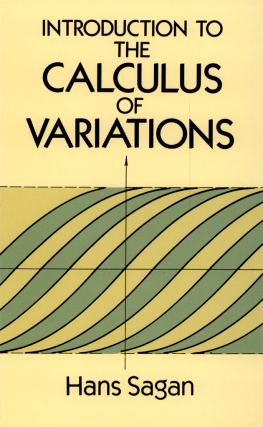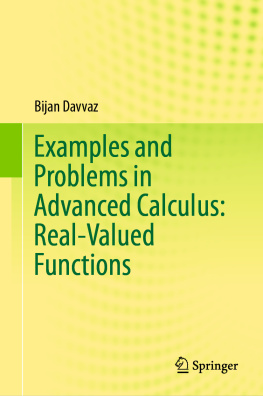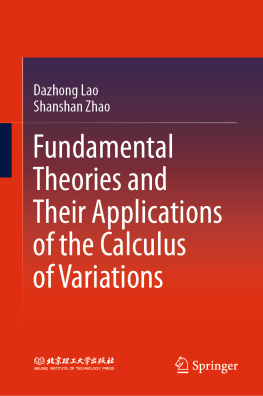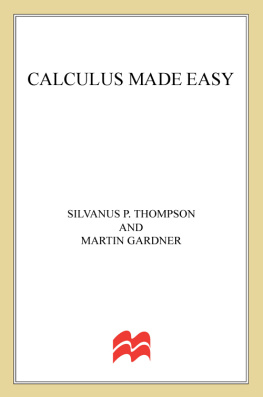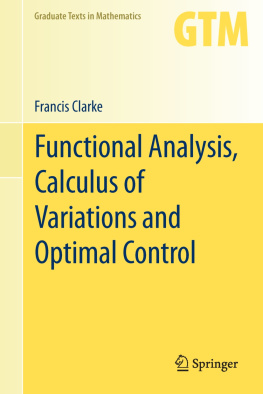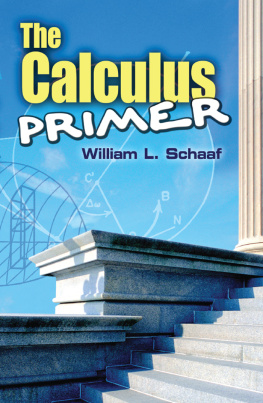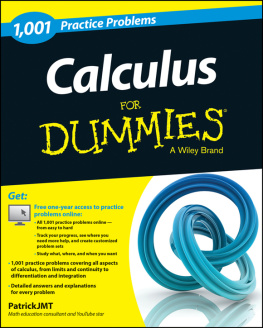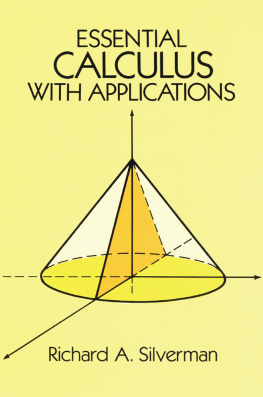Hans Sagan - Introduction to the Calculus of Variations
Here you can read online Hans Sagan - Introduction to the Calculus of Variations full text of the book (entire story) in english for free. Download pdf and epub, get meaning, cover and reviews about this ebook. year: 1992, publisher: Dover Publications, genre: Science. Description of the work, (preface) as well as reviews are available. Best literature library LitArk.com created for fans of good reading and offers a wide selection of genres:
Romance novel
Science fiction
Adventure
Detective
Science
History
Home and family
Prose
Art
Politics
Computer
Non-fiction
Religion
Business
Children
Humor
Choose a favorite category and find really read worthwhile books. Enjoy immersion in the world of imagination, feel the emotions of the characters or learn something new for yourself, make an fascinating discovery.
- Book:Introduction to the Calculus of Variations
- Author:
- Publisher:Dover Publications
- Genre:
- Year:1992
- Rating:3 / 5
- Favourites:Add to favourites
- Your mark:
- 60
- 1
- 2
- 3
- 4
- 5
Introduction to the Calculus of Variations: summary, description and annotation
We offer to read an annotation, description, summary or preface (depends on what the author of the book "Introduction to the Calculus of Variations" wrote himself). If you haven't found the necessary information about the book — write in the comments, we will try to find it.
Introduction to the Calculus of Variations — read online for free the complete book (whole text) full work
Below is the text of the book, divided by pages. System saving the place of the last page read, allows you to conveniently read the book "Introduction to the Calculus of Variations" online for free, without having to search again every time where you left off. Put a bookmark, and you can go to the page where you finished reading at any time.
Font size:
Interval:
Bookmark:
2
3
4
5
6
7
8&
9*
10<
11=
12>
13u
14
15
16
17
18
19
20
21
22
23
24
25
26
27
28
29
30
31
32
33
34
35
36
37
38
39
40
41
42
43
44
45
46
47
48
49
50
51
52
53
54
55
56
57
58
59
60
61
62
63
64
65
66
67
68
69
70
71>
Originally published : New York : McGraw-Hill, 1969, in series : International series in pure and applied mathematics. Includes bibliographical references and index. eISBN: 9780486138022 1. Calculus of variations. I. Title.
QA315.S23 1992 515.64dc20 92-2356
CIP PREFACE The calculus of variations has attracted the attention of numerous eminent mathematicians, who have made significant and lasting contributions to its development since its inception 273 years ago. Early this century, when the problem of Bolza in its overwhelming generality was formulated and analyzed, most of the problems that were considered to lie within the province of the calculus of variations appeared to be solved, or at least solved in principle, and interest in the subject began to decline. Only in the last decade or so has a new upsurge of interest become noticeable. This is partly due to the novel demands of a new and sophisticated technology, in which space technology occupies a prominent position. Another factor in this revival of the calculus of variations is the availability of high-speed computing devices, which, together with newly developed mathematical algorithms, make it possible to solve many variational problems which heretofore could only be solved in principle. The modern theory of optimal control, which has been developed in recent years and is still in a process of growthin depth as well as in scopehas its roots in the calculus of variations, although many of its techniques are new and more easily adaptable to practical technological requirements than are the methods of the classical calculus of variations.
It is the purpose of this text to lay a broad foundation for an understanding of the problems of the calculus of variations and of its many methods and techniques, with their many-faceted subtleties, and to prepare the reader for the study of modern optimal control theory. The treatment is limited to a thorough discussion of single-integral problems in one or more unknown functions, where the integral is employed in the riemannian sense. The functions that are admitted are at worst sectionally smooth. Such a setting seems general enough for most practical purposes and, at the same time, keeps the formulation and the proofs on a simple enough level. The problem in two or more independent variables is given peripheral treatment in the appendices to ). The first three chapters deal with variational problems without constraints.
The theory of the first variation and the theory of fields are developed as far as seems practical and to a point beyond which the arguments would become tiresome and repetitious. . In Chap. is devoted to a discussion of its application to time-optimal control problems and to control problems of fixed duration that are associated with a nonautonomous system of differential equations. is devoted to a derivation of the multiplier rule for the problem of Mayer with fixed and variable endpoints and its application to the problem of Lagrange and the isoperimetric problem. , are derived within the framework of the theory of the second variation. , are derived within the framework of the theory of the second variation.
A new result that is derived in this chapter is Jacobis necessary condition for a weak relative minimum. I have resisted the temptation to include the customary chapter on direct methods because to do this subject justice, one would have to devote an entire book to it. Not only is the method of attack quite distinct from the methods employed in this book, but the variational problems and the concept of the minimum itself change their character substantially owing to a different concept of the space of competing functions. This book contains essentially the material I have developed during the past ten years in courses taught at the University of Idaho and North Carolina State University and in a series of lectures which I have delivered over the past five years to engineers and scientists at the Astromechanics Branch of the Space Mechanics Division of the National Aeronautics and Space Administration at Langley Field, Virginia. I have used elementary functional analytical methods in the discussion of the foundations of the theory of the first and the second variation, not to appear modern at any price, but principally because the functional analytical setting provides a much better and deeper understanding of the fundamental concept of the space of admissible variations and the concepts of a weak and a strong relative minimum of an integral. I have tried to avoid repetitive arguments whenever feasible by using different approaches to the same concept at various stages of generality.
Thus Bellmans fundamental partial differential equation is derived first by a method of Carathodory and then, in a more general setting, by Bellmans method of needle-shaped variations. The theory of fields and the Weierstrass excess function are introduced on three separate occasions by three different methods. Some of the interrelations of the various approaches to the solution of variational problems are spelled out in detail, some are merely hinted at, and some are left for the reader to discover. This book was written primarily for the student. To achieve greater clarity, care has been taken to spell out difficult steps in some detail, often at the expense of mathematical elegance. Every theorem is either preceded immediately by a derivation or succeeded by a proof, with one exception.
The exception is the fundamental theorem on underdetermined systems on which the multiplier rule for the Mayer problem is based. To give the reader a chance to familiarize himself with the notation and with the content of this theorem, the proof is postponed until after the theorem has been applied to a number of special cases. To illustrate a complicated situation with a complicated problem compounds the difficulties. Therefore, the examples discussed in the main body of the text (which are set aside from the main text by the use of smaller print) have been kept at a simple and technically uncomplicated level, uncluttered by extraneous matters and stripped of all unnecessary constants. There are 421 exercises interspersed throughout the text. Some of these exercises are intended to develop mastery of the formalism, some (which are marked by an asterisk) complement the text, and still others lead beyond the material presented in the text.
In order to read this book with profit or to take a course based on this book with a reasonable chance for success, the student should be able to use the implicit-function theorem in a variety of situations, he should be familiar with the Heine-Borel theorem, and he should know the standard existence and uniqueness theorems from the theory of ordinary differential equations. To put this in more conventional terms, the student should have had a course in advanced calculus and an intermediate course in ordinary differential equations. Some knowledge of the elements of matrix algebra would be helpful in . The material is arranged to give the user the greatest possible amount of flexibility. The material contained in the main portions of the chapters (excluding appendices) can be taught comfortably in a one-semester course, possibly by omitting .
Font size:
Interval:
Bookmark:
Similar books «Introduction to the Calculus of Variations»
Look at similar books to Introduction to the Calculus of Variations. We have selected literature similar in name and meaning in the hope of providing readers with more options to find new, interesting, not yet read works.
Discussion, reviews of the book Introduction to the Calculus of Variations and just readers' own opinions. Leave your comments, write what you think about the work, its meaning or the main characters. Specify what exactly you liked and what you didn't like, and why you think so.

